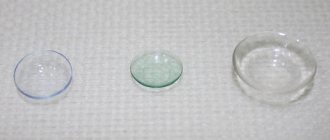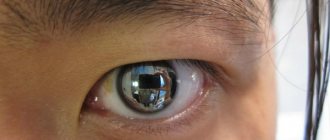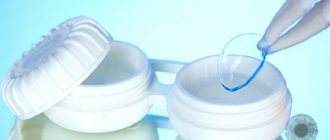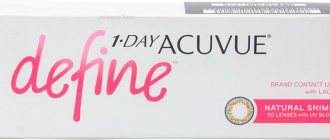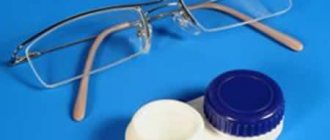What is unique about night wear lenses?
The cornea is the transparent membrane that covers the front of the eye. It has no blood vessels, has a high refractive power and is part of the optical system of the eye. The cornea borders the opaque outer layer of the eye, the sclera.
Overnight contact lenses provide a temporary reduction in myopia (nearsightedness) by changing the shape (straightening) of the naturally elastic cornea. A slight change in its curvature reduces the excessive refractive power of the myopic eye and completely compensates for myopia.
Criteria for choosing night lenses
Not everyone understands why a person needs lenses while sleeping. In fact, this is one of the modern methods of vision correction, which is successfully used for astigmatism and myopia. Ortho-K lenses have reverse geometry. Their periphery is not as flat as the center. To choose the right vision correction product, it is important to remember the following rules:
- Lenses should be used as prescribed by an ophthalmologist. They are selected individually for each patient.
- During the day they are not needed.
- Optical products are suitable for people from 7 to 40 years old.
- Every 3 months you should consult a doctor.
- Night lenses require special care. If treated correctly, they will not cause harm.
- Solutions for soft contact lenses are completely unsuitable for overnight storage.
- When calculating your budget, it is worth taking into account the costs of the examination and accessories - cleaning solution, storage container.
- Lenses are changed approximately once every 12 months.
It remains to get acquainted with the participants in our review, their advantages and disadvantages.
How do night wear lenses work?
Night wear lenses are placed directly on the cornea, just like regular contact lenses, only 10-15 minutes before bedtime. Due to their special design and reverse geometry, they gently influence the shape of the cornea, thereby temporarily improving vision due to a reversible change in the curvature of the cornea.
Clinical trials confirm that after wearing the lens for 6–8 hours, the cornea retains its altered shape for a long time when a person is awake (up to 24 hours), so there is no need for additional correction (glasses, contact lenses) during the day.
Selection rules and preparation
If the patient uses CL, then it is necessary to obtain the correct initial corneotopogram data and correctly measure the parameters of the cornea. To do this, a break is required. It helps restore the corneal surface.
When a person wears rigid gas-permeable lenses, he refuses to use them for a period of 2–4 weeks, and SCLs - for a period of up to 7 days. After the recommended period, the doctor can select orthokeratology products.
The patient examination includes the following procedures:
- Refractometry – autorefractometry, skiascopy. Methods identify ametropia and its magnitude.
- Visometry - the doctor determines the visual acuity of the subject.
- Keratotopography is a non-contact diagnostic method that determines the relief of the cornea and the degree of impairment.
- Keratometry is a test used to measure the curvature of the cornea.
An ophthalmologist can perform additional diagnostic methods. Sometimes an ophthalmologist needs to review several options in order to select the appropriate CL according to a person’s parameters.
The attending doctor adheres to several criteria:
- high visual acuity during orthokeratology therapy;
- gradual decrease in vision if there are breaks in wearing;
- during the studies necessary to measure the refractive power of the eye, the doctor receives data on emmetropic refraction.
When a patient is prescribed orthokeratology treatment, he must wear contact lenses and sleep for 7 hours. After this, the ophthalmologist conducts a second examination and analyzes the data obtained. In the absence of pathologies, the doctor recommends ortholenses to the patient.
Who can be recommended for orthokeratology (night wear lenses)?
- Patients with refraction from –0.5 to –6.0 D.
- Patients with astigmatism up to –1.75 D.
- Those who, due to professional conditions (dust, temperature changes, high humidity, dry and hot climate), cannot use glasses or daily contact lenses.
- People with intolerance to soft contact lenses (allergic reaction, oxygen starvation of the cornea, ingrowth of blood vessels into the cornea, marked decrease in corneal sensitivity, dry eye syndrome).
- The lenses are suitable for those who cannot undergo laser vision correction due to the cornea being too thin.
- Patients aged from 6 to 40 years.
Advantages and disadvantages of the method
Night lenses are highly likely to slow down the progression of myopia. Thanks to its effect on the cornea, the product corrects vision, reduces visual fatigue and increases performance. As a result, there is an improvement in functional indicators.
Throughout the day, the user only needs to use night CLs. He has complete freedom from other correction methods.
The method is not accompanied by irreversible risks that occur with surgical interventions; the effect is completely reversible. Orthokeratological products are convenient for sports, including water sports.
According to experts, orthokeratology therapy in rare cases causes dry eye syndrome: tear fluid is evenly distributed during the daytime. Night lenses most often do not cause allergies.
Contraindications include:
- history of diseases of the cornea - degenerative-dystrophic disorders, keratitis;
- current inflammatory disease of the organ of vision;
- severe dry eye syndrome;
- the occurrence of negative consequences during the previous use of contact lenses, which are associated with violation of the wearing and care regime;
- diabetes;
- lagophthalmos;
- increased intraocular pressure;
- hormonal treatment;
- period of bearing a child;
- systemic diseases.
Temporary contraindications include:
- seasonal allergies;
- use of medications that reduce tear production;
- prolonged wearing of hydrogel contact lenses;
- wide pupil in adult patients;
- condition after refractive surgery (Femto Lasik, Smile);
- dry eye syndrome caused by wearing soft contact lenses and compensated by spectacle correction.
What is important to remember!
- On the 2nd day after lens selection, you need to come for an examination with your doctor. Most likely, he himself will set a suitable time. You need to come to the clinic with lenses already installed (i.e., put them on in the morning and leave them on until your appointment).
- To make wearing lenses comfortable, you need to regularly visit an ophthalmologist. Mandatory examinations at the Excimer clinic are carried out both on the second day and after a week, a month, and then once every three months throughout the year.
- If you are wearing lenses for the first time and you have a feeling of a foreign body, you CANNOT fall asleep with such a sensation. You need to remove the lens, wash it, moisten it and reinstall it. If the unpleasant sensation does not disappear, it is not recommended to wear the lens.
- Purchase only in a specialized salon or clinic.
- It is important to properly store and handle contact lenses; you must not exceed the period of wearing and storing them.
The best classic extended wear night lenses
Air Optix (Alcon) Night & Day Aqua (3 lenses)
Rating: 4.9
A well-deserved first place is occupied by lenses from Alcon, which are a real bestseller among extended-wear products. They are made from an innovative biocompatible material, lotrafilcon A. It has a high oxygen permeability (175 Dk/t), which is especially important during sleep. This is 6 times more than other lenses. A pair can be put on once and worn without taking it off for a whole month. At the same time, the optics do not require mandatory maintenance and cleaning.
The unique aspherical surface eliminates aberration, which in turn improves vision clarity. The manufacturer took into account the frequent occurrence of dryness when wearing extended lenses, so it reduced the water content as much as possible (24%).
According to reviews, with Air Optix you can enjoy life and perfect vision without experiencing discomfort and without the need for daily care. One package contains 3 lenses. Made entirely in the USA.
Advantages
- high level of breathability;
- continuous wearing for a month;
- minimum water content;
- innovative material;
- soft, not felt on the eyes;
- does not cause dryness.
Flaws
- not identified.
Biofinity 6 lenses Monthly
Rating: 4.8
The silver winner is optics from the American company Biofinity. Wearing mode is variable. This means that the user himself chooses to use the lenses continuously for 7 days or only during the day, but for a month. Many call them the most comfortable to wear. This is achieved through the use of unique Aquaform technology, which provides intense eye hydration and a feeling of comfort.
Features include high oxygen permeability (160 Dk/t) and aspherical design. Each package includes 3 pairs, which, depending on the chosen wearing mode, are enough for a period of 3 weeks to 3 months. Another advantage of these night contact lenses is their resistance to deposits.
Customers share positive impressions of using Biofinity optics. They love the feel, high quality and reasonable price. The product is a joint development of specialists from the USA and Great Britain.
Advantages
- application of unique technology;
- wearing option: 7 days/6 nights without interruption;
- resistance to dehydration;
- comfortable feeling while wearing;
- excellent throughput.
Flaws
- not identified.
Benefits of night wear lenses
- Unlike daily wear lenses, orthokeratology lenses are placed on the cornea at night and during the day, when oxygen absorption is more active, they do not interfere with this process. Therefore, during refractive therapy there is no state of hypoxia (oxygen starvation), which can lead to the ingrowth of blood vessels into the cornea (neovascularization).
- When wearing lenses, tear exchange is not disrupted. Consequently, a tear removes soluble waste products from the cornea, particles of dust and smoke, and also transports nutrients to the cornea.
- Refractive therapy with orthokeratology lenses eliminates the limitations associated with wearing glasses and soft contact lenses.
Night wear lenses are safe!
According to statistics, 80% of those who use refractive therapy methods are children, because vision correction operations are not performed until the age of 18. World experience has shown that in children using orthokeratological lenses, the progression of myopia slows down, and in 40% of cases it stops completely.
Selection of orthokeratological (night) lenses
The Central Ophthalmology Clinic presents a unique method of vision correction.
Selection of orthokeratological lenses is carried out by appointment !
What is orthokeratology ?
• a new NON-surgical method of vision correction using Paragon night lenses - a leader in the production of OCL - original lenses, supplied from the USA.
• the only method today that allows, in most cases, to stop the development of myopia in children and adolescents, i.e. As the child grows, vision does NOT deteriorate in 70% of cases, which usually happens when wearing glasses or contact lenses.
• This technique has existed since the 60s, it is successfully used in 53 countries in more than 5,000 clinics and is very popular among patients.
• “reversible” method (if you do not wear OKL for a month, the eyes will return to their original state)
• This technique was included in the Federal Clinical Guidelines “Diagnostics and Treatment of Myopia in Children” in 2014 (clause 8.3).
• You don’t risk anything - try it - you can return the entire amount without loss.
• The price is cheaper than wearing SCL (monthly)
Who is suitable for refractive therapy?
• people with myopia up to 6.0 diopters and astigmatism up to 3.0 diopters;
• people with farsightedness up to 3.0 diopters and astigmatism up to 1.5 diopters;
• patients with thin corneas who cannot undergo laser vision correction;
• patients who, due to professional requirements, cannot wear glasses and soft contact lenses, but must have 100% vision (athletes, pilots, high-altitude installers, military, divers, builders, miners);
• people involved in sports;
• patients who are intolerant to soft contact lenses.
How do night lenses work?
Lenses have two different surfaces. The outer surface - optical - actively refracts light (like ordinary lenses) and makes it possible to obtain 100% vision in them. The internal therapeutic surface has a complex shape that actively affects the surface layer of the cornea and causes the corneal cover cells to migrate in a dosed manner from the center to the periphery. Cells, remaining alive, occupy new places. In this case, the refractive power of the cornea changes to exactly the required amount. When the patient removes the lens, the effect lasts up to 48 hours, the image is focused on the retina and the person sees clearly.
Why do customers choose Paragon CRT night lenses?
Paragon CRT lenses are made from 100% gas permeable material - purified fluorosilicone acrylate - Paflufcon. The creation of this amazing material, which made it possible to produce lenses with 100% oxygen permeability, was preceded by 10 years of research, including several space flights to study the physical properties of materials (polymerization) under weightless conditions. Today, all the world's leading companies producing refractive therapy lenses use Paragon material.
In 2002 Paragon was the first company in the world to receive FDA (USA) certification for nighttime use of orthokeratology lenses without age restrictions (including for use in children). In 2010, Paragon CRT orthokeratology lenses were approved for use in the Russian Federation by order of Roszdravnadzor No. 5357-Pr/10.
Selecting Paragon CRT orthokeratology lenses is a crucial moment. Properly selected lenses are the key to their effective operation and achievement of 100% vision. Therefore, the selection of lenses is carried out by specialists who have undergone original training at Paragon (USA), for which they have the appropriate diplomas.
Lenses are worn at night. Well-fitted lenses provide complete comfort with your eyes closed. Lenses should be put on 10-15 minutes before bedtime. The average time to wear lenses at night is 6 to 8 hours. The very next morning after the first night of wearing lenses, your vision will improve significantly, but may not reach 100%. A lasting final effect (100% vision) will be achieved within 7-14 days (depending on the degree of initial myopia).
Why should children use night lenses?
Refractive therapy can help nearsighted children.
First, children and adolescents should not undergo refractive surgery until they are 18 to 21 years old.
Secondly, world experience in the use of refractive therapy has shown that, in comparison with children using correction with glasses or daytime contact lenses, in children and adolescents using the Refractive Therapy method, the progression of myopia slows down, and in 40% of cases it is possible to completely stop the development of myopia .
Third, refractive therapy eliminates all the waking restrictions associated with wearing glasses and regular contact lenses. You can run, jump, swim, rub your eyes, etc.
Fourthly, the use of night lenses allows you to relieve the psychological problems of children associated with wearing glasses.
The fact is that when wearing glasses, the muscular apparatus of the child’s eye does not develop physiologically. The muscles responsible for focusing the eye are usually weaker than in a healthy eye. The use of glasses correction does not allow muscles to develop and train to their full potential, and myopia continues to increase. Until now, in order to stop the progression of myopia, various methods of hardware muscle development (myostimulation, electrophoresis, magnetic therapy) have been used. However, these procedures take a lot of time for children, tie them to medical centers, and most importantly, do not fundamentally solve the problem. After all, having stopped exercising on devices, the child and his eyes find themselves in the same unfavorable conditions of visual stress. When refractive therapy is used, the child's eye becomes virtually emmetropic (i.e., has good vision - without myopia) and all internal systems of the eye develop correctly, resulting in a stop in the progression of myopia.
Thus, the child lives an active and full life with good vision and at the same time trains his eyes throughout the day!
Sign up for a selection of orthokeratology lenses right now!
Reception is carried out at the address:
Belgorod, st. Sadovaya, 30
Regular customers get a 15% discount!
The selection of night lenses is additionally paid - 1500 rubles.
Make an appointment by phone number: 8 (4722) 232-911



